A marriage penalty results when a married couple pay more taxes by filing jointly than they would pay if each spouse could file as a single person. A couple face the marriage penalty only when both spouses have earned income. Single-earner couples never pay a penalty and in fact always get a bonus from the Tax Code, paying less taxes than they would pay as singles.
Source of the Penalty: Progressive Tax Rates. The marriage penalty fundamentally results from progressivity of the Tax Code.1 This can be seen in Table I, which presents the federal income tax schedule for 1998. It shows how marginal income tax rates rise from 15 percent to 39.6 percent. The earnings of the secondary worker (the lower-paid spouse) in effect come on top of the primary earner's. Thus a secondary worker may find that his or her earnings push the couple's total income into a higher tax bracket, resulting in a marginal rate higher than the secondary worker would pay if taxed as a single.
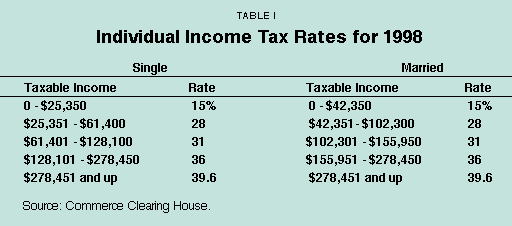
"A couple may either get a tax bonus or a tax penalty on the same total income, depending on what the income split is between husband and wife."
To see how this works, consider a husband with taxable income of $25,000 per year. Under both the single and joint tax schedules, he would pay 15 percent tax on that income. However, if his wife also makes $25,000, only the first $17,350 of her income would be taxed at 15 percent. The remaining $7,650 of her income would be taxed at 28 percent, because it puts the couple's total income above the $42,350 ceiling for the 15 percent bracket. Thus the couple would pay 13 percent more tax on that income (the difference between 15 percent and 28 percent) than the wife would if she were single. This couple's marriage penalty would be $994 per year.
Penalties and Bonuses. As Table II indicates, a couple may either get a tax bonus or pay a tax penalty on the same total income, depending on what the income split is between husband and wife. The couple in the earlier example paid the maximum marriage penalty on their $50,000 joint income because each spouse earned half the income. However, if one spouse earned substantially less than the other, the couple could have received a marriage bonus.
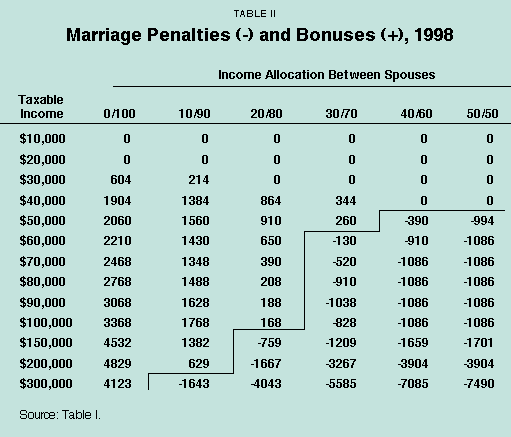
- If the husband earned $40,000 per year while the wife earned $10,000, instead of paying a penalty of $994 per year they would have received a bonus of $910.
- That is, they would pay $910 less in taxes as a couple filing jointly than they would pay if each were taxed as a single.
The marriage penalty is most likely to apply to couples whose incomes are roughly equal. As Table II indicates, no couple with equal incomes or incomes within 10 percent of each other receive a marriage bonus and most receive penalties. As noted earlier, no single-earner couples pay a marriage penalty and virtually all, regardless of income, receive a bonus.
Of course the data in Table II are hypothetical. They assume that all income is earned and that couples have no deductions other than the personal exemption and the standard deduction. In real life, people's incomes and deductions are more complicated. To get an idea of how marriage penalties and bonuses affect real people, the Congressional Budget Office (CBO) looked at Internal Revenue Service and Census data. The CBO found that the highest proportion of marriage penalties occurred when the higher-earning spouse made between $20,000 and $75,000 per year. As shown in Figure I, couples with incomes above and below these levels were more likely to receive a tax bonus for being married.
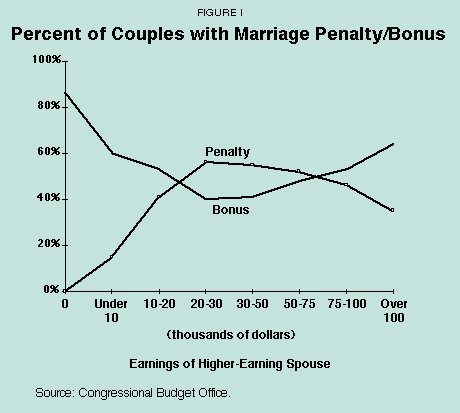
"Black couples are more likely to suffer a marriage penalty, while whites are more likely to receive a marriage bonus."
Impact on Black Families. Thus we see that marriage penalties are most likely to have an impact on couples with middle incomes whose incomes are roughly equal. Professor Dorothy Brown of the University of Cincinnati College of Law has argued that these two factors mean that blacks are more likely to suffer a marriage penalty, while whites are more likely to receive a marriage bonus.2 The reason is that among married couples, black women are more likely to work than white women. Furthermore, working black women on average provide a higher percentage of the couple's total income than working white women. According to a 1990 study by the U.S. Commission on Civil Rights:3
- Seventy-five percent of black women work full-time, whereas only 62 percent of white women do.
- Working black women contribute 40 percent of family earnings, while working white women contribute just 29 percent.
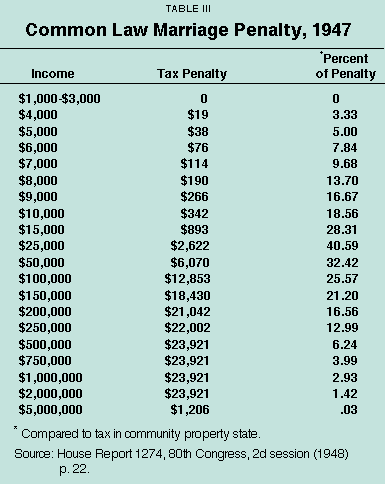
Although the marriage penalty is inherent in progressive tax rates, its magnitude has gone up and down with changes in the tax law. When the income tax was established in 1913, no distinction was made between married and unmarried taxpayers. A single rate schedule applied to both.
The tax problems related to working women were far fewer in those days because only a small number of married women worked outside the home. Even single women were unlikely to hold a paying job at that time.4
- In the census of 1900, only 769,000 married women were in the labor force, which totaled 27,640,000 workers.
- The female labor force participation rate was just 20 percent in 1900, compared to 86 percent for men.
Community Property. In the 1920s, a number of couples in community property states began filing separate tax returns, with each spouse claiming half the couple's total income.5 This was justified on the grounds that under community property each spouse is deemed to own half the couple's joint earnings, regardless of who earned them. By contrast, in common law states, the earnings of a spouse generally belonged to that spouse. Among the states with community property laws at that time were Texas, Arizona, Idaho, Louisiana, Nevada, New Mexico, Washington and California.
"In the 1940s, some couples in common law states were paying 40 percent more in federal taxes than they would have paid in a community property state."
Initially, the Attorney General of the United States ruled that couples in community property states could split their income for tax purposes. This had the effect of reducing taxes for most couples. For example, if a husband had $20,000 of earnings and his wife had none, they would be taxed as if each earned $10,000. This generally put them in a lower tax bracket and lowered their joint tax liability. Had this practice been allowed to continue, it would have led states to adopt community property laws just to give their citizens a cut in their federal income taxes.
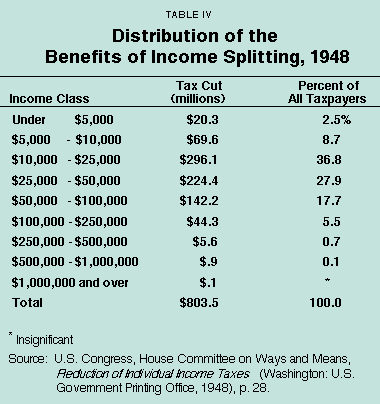
Congress and the Treasury Department attempted to thwart income splitting through legislation and regulations. Eventually, a case reached the Supreme Court. In Poe v. Seaborn (1930), the Court ruled that state community property laws did allow couples to split their incomes for federal income tax purposes. As expected, this led several states to change from common law to community property to give their citizens a tax cut at no expense to the state. The trend accelerated when tax rates shot up during World War II. By 1948 Oregon, Nebraska, Michigan and Oklahoma had changed their laws to become community property states.6
Obviously, this situation led to a great deal of unfairness, with residents of some states paying significantly lower federal income taxes than comparable earners residing in other states. Table III indicates the magnitude of the marriage penalty for couples in common law states in 1947. As the table shows, some couples in common law states were paying 40 percent more in federal income taxes than they would have paid in a community property state. For example:
- A couple with a joint income of $25,000 would have paid $9,082 in federal income taxes in a common law state.
- The same couple would have paid only $6,460 in a community property state.
As Professor Michael Graetz of Yale recently noted, "This absurd situation did not engender great respect for the integrity of the income tax."7
"When income splitting was extended to all married couples in 1948, it constituted a significant tax cut for most of them."
Income Splitting. Congress finally resolved this problem in the Revenue Act of 1948, which extended the principle of income splitting to all married couples.8 This constituted a significant tax cut for most married couples.9 As Table IV shows, the bulk of the benefits accrued to couples with middle incomes.

More significantly, almost every married couple saw a sharp reduction in their marginal tax rate – the tax that applies to the last dollar earned. A couple earning $51,000, for example, saw their marginal rate drop from 75 percent to 59 percent between 1947 and 1948. Figure II illustrates the impact. Again, those in the middle brackets, not the rich, were the principal beneficiaries.
"A couple earning $51,000, for example, saw their marginal tax rate drop from 75 percent to 59 percent."
In practice, the impact of lower tax rates was mainly on women. Since a married woman's earnings came on top of her husband's, she was in effect taxed at her husband's marginal tax rate on the first dollar of her earnings. Marginal tax rates as high as 90 percent after World War II strongly discouraged married women from working.
Although income splitting was highly beneficial to most married couples, it created a problem for single taxpayers. As a result of income splitting, a married couple now paid significantly less tax than a single earner with the same income. Congress tried to address this inequity in 1951 by creating a new tax rate schedule for single heads of households, which roughly split the difference between the married and single tax schedules.
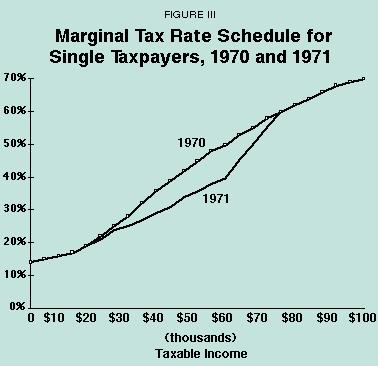
Birth of the Marriage Penalty. However, singles continued to agitate for tax relief. By 1969 some single taxpayers were paying 42 percent more federal taxes than a married couple with the same income. That year Congress created a new tax schedule that was designed to keep the tax burden on singles and married couples with the same income within 20 percent of each other. Figure III shows the tax rate reductions for single taxpayers that were effective in 1971. This legislation created a significant marriage penalty for the first time.10 As a result, some married couples now paid more taxes by filing jointly than they would have paid if both filed as individuals.11
"The 1981 tax bill did not eliminate the marriage penalty, but did provide substantial relief."
Further contributing to the rise of the marriage penalty was the steep increase in the number of women in the labor force. As Figure IV shows, the number of women in the labor force grew by about 50 percent between the late 1940s and the early 1970s. The labor force participation rate for women has continued to rise since and in 1997 was almost double the rate of 1947. This is important because a marriage penalty occurs only when a husband and wife both earn income. As women began working in greater and greater numbers, the likelihood of a couple suffering a marriage penalty rose.
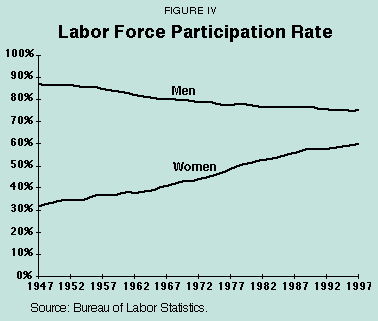
As awareness of the marriage penalty grew, increasing numbers of couples began to take matters into their own hands by getting divorced for tax reasons. One couple, David and Angela Boyter, received national publicity for getting divorced each December, allowing each to file as single for the year, then remarrying in January.12 Eventually the IRS cracked down on this charade, but not before moving Congress to action.13 By 1981, there was strong political pressure to redress the marriage penalty problem, and a variety of proposals were put forward.14
Recent Tax Changes. In the Economic Recovery Tax Act of 1981, Congress attempted to redress the marriage penalty by giving the lower-paid spouse a 10 percent tax deduction on income up to $30,000, for a maximum deduction of $3,000. While this provision did not eliminate the marriage penalty, it did provide substantial relief for most married taxpayers, as shown in Table V.
However, the secondary-earner deduction did not live long and was eliminated by the Tax Reform Act of 1986. But because the Tax Reform Act sharply reduced rates for most taxpayers, the net effect was to reduce the number of couples suffering a marriage penalty and the magnitude of the penalty.15 Nevertheless, some couples were worse off, as shown in Table VI.
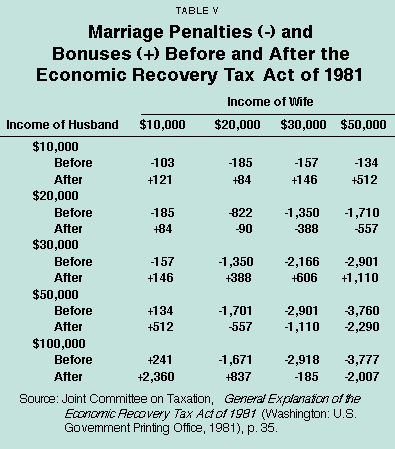
"Expansion of the Earned Income Tax Credit in 1993 exacerbated the marriage penalty."
The most recent tax legislation with a major impact on the marriage penalty was the 1993 tax bill.16 Interestingly, the provision of this legislation that exacerbated the marriage penalty was not the increase in tax rates but the expansion of the Earned Income Tax Credit (EITC). The EITC is a refundable income tax credit for workers with low earnings. It creates marriage penalties because it is phased out as incomes rise and because it is maximized for workers with two children.17 No additional credit is available for three or more children in a single qualifying family. Depending on their income, therefore, a two-earner couple might significantly increase their joint EITC benefit by divorcing. And if they have more than two children, the benefits of divorce can be enormous. For example, in 1996, a two-earner couple with four children and $11,000 each in earnings would have increased their EITC payment from $1,375 to $7,120 by getting divorced, with each spouse claiming two children.18 Table VII illustrates the impact of the 1993 tax legislation on couples at various income levels.
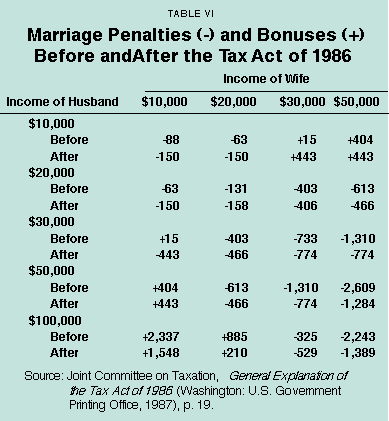
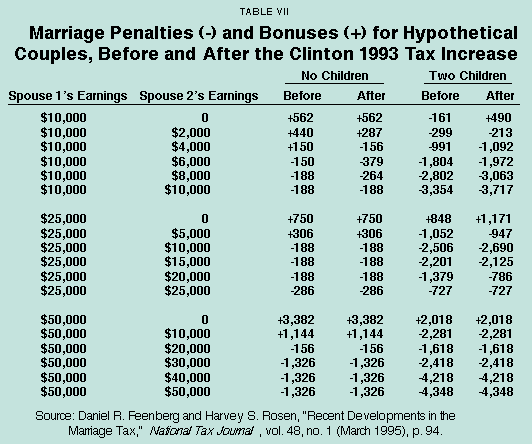
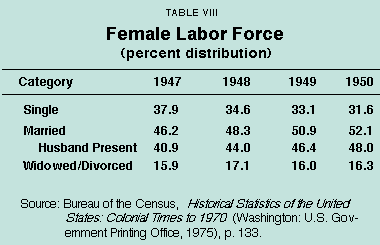
"The marriage penalty significantly discourages work effort among married women."
As noted earlier, the principal effect of the marriage penalty has been on wives, because they generally earn less than their husbands and thus are in effect taxed at their husbands' marginal tax rates. This means that wives generally receive less aftertax income on each dollar they earn than their husbands do. This significantly discourages work effort among married women. A considerable amount of economic research demonstrates that high marginal tax rates reduce labor supply, especially for married women.19
Labor Supply. The disincentive effects of high marginal tax rates on married women are aggravated by their looser attachment to the labor force than men and by their child-rearing responsibilities.20 Although most married women who work do so because of financial necessity, many do not. Their income is not essential for maintaining a couple's standard of living. Such women may work for a variety of reasons, including the simple joy of doing so. But the consequence is that they are more easily driven from the labor force by tax disincentives than are married men. For this reason, economic theory suggests that married women should be taxed less than married men.21
Thus it should come as no surprise that tax policies affecting the marriage penalty have had a significant impact on female labor supply. The institution of income splitting in 1948 and the effective reduction in marginal tax rates had a major effect on women's work decisions. As Table VIII shows:
- Between 1947 and 1950 the labor force participation rate for married women shot up, raising their share of the female labor force from 46.2 percent to 52.1 percent.
- Those with a husband present, who were most likely to be affected by income splitting, increased their labor force participation most, increasing their share of the female labor force from 40.9 percent to 48 percent.
- By contrast, the labor force participation of single, widowed or divorced women, who gained nothing from income splitting, stayed flat or declined.
The labor force participation rate for men was also unchanged over this period.
A study of the 1981 tax act, which reduced the marriage penalty by instituting a secondary-earner deduction, shows that married women's work expanded by almost enough to pay for the deduction's revenue loss.22 Analysis of the Tax Reform Act of 1986, which lowered the top marginal tax rate from 50 percent to 28 percent, shows that married women responded more strongly than men to the increased work incentive.23 Another study estimated that:24
- If the marriage penalties remaining after the Tax Reform Act were eliminated, the average married woman would work 46 more hours per year.
- High-income and low-income women would respond even more strongly, increasing their work hours by 100 hours per year.
"Sharply cutting the tax rate on secondary workers could led to an increase of as much as $66 billion per year in their earnings."
The latest estimates by economists Martin Feldstein and Daniel Feenberg suggest that the labor supply response of married women to reduction of the marriage penalty today could be quite large. Sharply cutting the tax rate on secondary workers could lead to an increase in earnings by such workers of as much as $66 billion per year.25
Marriage or Divorce. In addition to effects on labor supply, the marriage penalty also impacts the marriage/divorce decision. There is certainly no question that over time the number of couples living together without marriage has sharply increased.
- The Census Bureau reports that 523,000 adults of the opposite sex were living together in 1970.
- By 1996, this figure had risen to 3,958,000.
In 1970 just 0.5 percent of the couples in the United States were unmarried. By 1996 this percentage had risen to 7.2 percent. At least some of this is undoubtedly due to tax considerations.
Several studies have looked at this question. They find that the marriage penalty has a small but significant impact on couples' decision to marry. When the marriage penalty rises, aggregate marriage rates fall. The impact on the timing of marriage is even greater, with couples often marrying late in the year to minimize their marriage penalty.26 Finally, there is some evidence that taxes encourage divorce, especially on the part of women who are affected most by the marriage penalty.27
[page]As noted earlier, from 1913 to 1948 Congress adopted an approach to taxation that did not differentiate between married and unmarried persons. There was only one tax schedule, and everyone paid the same rates. A single person and a married couple with the same income paid the same tax. Congress did not willingly adopt income splitting in 1948. It was forced to do so out of necessity resulting from the consequences of a Supreme Court case. Nevertheless, the effect was to replace the individual with the family as the fundamental unit for taxation.
It has long been known that a tax system cannot simultaneously do three things: (1) have progressive tax rates, (2) treat couples with the same income equally and (3) have a neutral effect on marriage.28 If the first goal is taken as given, one must choose between the second and third. In 1948 Congress chose the first and second and abandoned the third.
"A system of individual filing would be fairer, simpler and more efficient."
Progressivity. In recent years a number of tax theorists have questioned that congressional decision. Progressivity is no longer assumed to be a primary criterion of our tax system. Increasingly, tax theorists question whether it is fair to penalize those with higher incomes, while economists produce more and more data on the economic cost of progressivity. At the same time, others question family-based taxation. They argue that a system of individual filing would be fairer, simpler and more efficient.
The notion of progressivity has been under attack for many years. Tax experts have long known that exemptions, deductions and exclusions in the Tax Code can easily erode the nominal progressivity of the rate structure. They have also known that progressivity breeds complexity and evasion and imposes a large deadweight cost on the economy. But the idea that "fairness" demanded higher tax rates on those with upper incomes was too widespread to challenge.29
By the 1980s, opinion had shifted enough to permit serious support for a flat tax with a single rate for all taxpayers, regardless of income. So popular was the idea that in 1986 Congress moved toward a flat tax by creating a two-rate system, with a top rate of just 28 percent. Eventually, even academic tax theorists began to come around to the idea. Now criticism of progressivity appears in leading law journals, where earlier it would have been unthinkable.30
At the same time, economists have increasingly come to see the cost of progressivity as extremely high. One study put it this way:31
Even a mild degree of progressivity in the income tax system (as measured by the steepness of the marginal rate schedule) imposes a very large efficiency cost. For example, in comparison with an equal revenue proportional income tax, a progressive income tax with average tax rates varying over the life cycle between .23 and .32 and marginal rates ranging from .23 to .43 imposes an efficiency cost greater than 6 percent of full lifetime resources.
Since that study appeared, many others have reached similar conclusions about the overall welfare cost of progressivity in the U.S. tax system.32 As a result, a recent president of the American Economic Association stated, "Today, it is fair to say that many, if not most, economists favor the expenditure tax or flat rate income tax. This group has joined the opponents of progressive taxation in the attack on the income tax."33
"There is no particular reason why married couples should receive special treatment from the Tax Code."
Tax Unit. Just as progressivity increasingly has become questioned, many tax theorists have begun questioning whether the family should be the fundamental unit of taxation. They suggest that the individual is the more appropriate unit of taxation. Such a move would eliminate not only the marriage penalty but also the marriage bonus. The bonus may be inappropriate because there is no particular reason why married couples should receive special treatment from the Tax Code. To aid children, tax deductions or credits could target children rather than families.34
Individual taxation may also be better suited to changing societal mores. In 1948 relatively few women worked, few headed households and most couples had a single earner. Now women work in almost the same percentages as men, female-headed households are common and families represent a decreasing share of households. Indeed, growth of the marriage penalty is as much due to demographic changes as to changes in the tax law.35 According to the Census Bureau, nonfamily households have risen from 18.8 percent of all households in 1970 to 30.1 percent in 1996.36 It is also worth noting that most major industrialized countries use the individual as the basic unit of taxation.37
[page]It is not necessary to completely abandon the family as the basic unit of taxation in order to eliminate the marriage penalty. It would only require allowing couples the choice of filing as singles or jointly. This would preserve marriage bonuses for single-earner couples but eliminate the marriage penalty for two-earner couples. However, Congress would also have to pass rules about dividing joint income, such as interest and dividends, and allocating itemized deductions, such as for mortgage interest and dependents.38
The major objections to the choice approach are complexity, cost and abandonment of the principle that couples with the same income should pay similar taxes. It would be complex because many couples would, in effect, have to do their taxes twice: first jointly and then as singles to see which way they would come out ahead. Also, whatever rules are adopted for allocating joint income and deductions are bound to be complicated.
Allowing couples to choose their filing status also would be costly. According to the CBO, doing so would have reduced federal revenues by $29 billion in 1996.39 It would also lead to situations in which certain couples would pay less total taxes than others with the same income. This could create pressure in future years for further tax measures to redress this perceived imbalance. Congress certainly needs to be wary about adding additional complexity to an already overly complicated Tax Code. However, in recent years Congress has enacted a number of very complicated provisions to the tax law involving phase-outs for various tax benefits that also have the effect of worsening the marriage penalty for some couples. For example, the child tax credit is phased out for couples with incomes over $110,000 and for singles with incomes over $75,000. This means that a couple making $75,000 each would qualify for the full $500 per child credit if they divorce but receive nothing if married.40
"A flat tax or national retail sales tax would be a better solution than more tinkering with the Tax Code."
Almost any solution to the marriage penalty is likely to increase complexity and raise questions about cost and fairness.41 Short of going all the way to an individual filing system, other options for redressing the marriage penalty include restoration of the second-earner deduction, such as that included in the 1981 tax bill, widening tax brackets and modifying provisions such as the EITC that create marriage penalties.42 Given the cost of full elimination of the marriage penalty and budgetary realities, in the end Congress will probably be forced to choose among these more limited options if it decides to address the issue at all.
A better solution to further tinkering with the Tax Code would be a flat tax or national retail sales tax. By eliminating progressivity, they get at the root cause of the marriage penalty.43 Although there are many other arguments for a flat tax, this one may prove most persuasive to two-earner couples.
NOTE: Nothing written here should be construed as necessarily reflecting the views of the National Center for Policy Analysis or as an attempt to aid or hinder the passage of any bill before Congress.
[page]- Other factors contributing to the marriage penalty are the standard deduction, personal exemptions, the Earned Income Tax Credit, phase-outs for personal exemptions and the limitation on itemized deductions. See Congressional Budget Office (CBO), For Better or for Worse: Marriage and the Federal Income Tax (Washington: U.S. Government Printing Office, 1997), pp. 15-25.
- Dorothy A. Brown, "The Marriage Bonus/Penalty in Black and White," University of Cincinnati Law Review, vol. 65, no. (Spring 1997), pp. 787-98.
- U.S. Commission on Civil Rights, The Economic Status of Black Women: An Exploratory Investigation (Washington: U.S. Government Printing Office, 1990), pp. 100, 105.
- Bureau of the Census, Historical Statistics of the United States: Colonial Times to 1970, part 1 (Washington: U.S. Government Printing Office, 1975), pp. 132-33.
- The following discussion draws heavily on Joint Committee on Taxation (JCT), The Income Tax Treatment of Married Couples and Single Persons, Joint Committee Print JCS-17-80 (Washington: U.S. Government Printing Office, 1980), pp. 19-25.
- For a discussion of the spread of community property laws and other means by which people attempted to exploit the opportunity to split incomes, see Carolyn C. Jones, "Split Income and Separate Spheres: Tax Law and Gender Roles in the 1940s," Law and History Review, vol. 6, no. 2 (Fall 1988), pp. 259-310.
- Michael J. Graez, The Decline (and Fall?) of the Income Tax (New York: Norton, 1997), p. 31.
- For details, see Stanley Surrey, "Federal Taxation of the Family – The Revenue Act of 1948," Harvard Law Review, vol. 61, no. 7 (July 1948), pp. 1097-1164.
- This legislation passed a Republican Congress and was enacted over President Truman's veto.
- For evidence that small marriage penalties existed for some taxpayers before 1969, see John Brozovsky and A.J. Cataldo II, "A Historical Analysis of the 'Marriage Tax Penalty,'" Accounting Historians Journal, vol. 21, no. 1 (June 1994), pp. 163-87.
- Grace Blumberg, "Sexism in the Code: A Comparative Study of Income Taxation of Working Wives and Mothers," Buffalo Law Review, vol. 21, no. 1 (Fall 1971), pp. 49-98; Joyce Nussbaum, "The Tax Structure and Discrimination against Working Wives," National Tax Journal, vol. 25, no. 2 (June 1972), pp. 183-91.
- This worked because for tax purposes a couple are regarded as married for the full year if married on December 31, and they are considered separated for the full year if divorced on that day. For these and other complications regarding whether a couple is or is not married for tax purposes, see Toni Robinson and Mary Moers Wenig, "Marry in Haste, Repent at Tax Time: Marital Status as a Tax Determinant," Virginia Tax Review, vol. 8, no. 4 (Spring 1989), pp. 788-819.
- Graetz, Decline of the Income Tax, pp. 35-38.
- Lynda S. Moerschbaecher, "The Marriage Penalty and the Divorce Bonus: A Comparative Examination of the Current Legislative Proposals," Review of Taxation of Individuals, vol. 5, no. 2 (Spring 1981), pp. 133-46.
- Harvey S. Rosen, "The Marriage Penalty Is Down but Not Out," National Tax Journal, vol. 40, no. 4 (December 1987), pp. 567-75; Douglas W. Mitchell, "The Marriage Tax Penalty and Subsidy Under Tax Reform," Eastern Economic Journal, vol. 12, no. 2 (April-June 1989), pp. 113-16.
- Daniel Feenberg and Harvey S. Rosen, "Recent Developments in the Marriage Tax," National Tax Journal, vol. 48, no. 1 (March 1995), pp. 91-101; Gregg A. Eisenwein, "Marriage Tax Penalties after the Omnibus Budget Reconciliation Act of 1993," CRS Report for Congress, 93-1000E (November 19, 1993).
- Anne L. Alstott, "The Earned Income Tax Credit and the Limitations of Tax-Based Welfare Reform," Harvard Law Review, vol. 108, no. 3 (January 1995), pp. 559-64; Edward McCaffery, "Taxation and the Family: A Fresh Look at Behavioral Biases in the Code," UCLA Law Review, vol. 40, no. 4 (April 1993), pp. 1014-20.
- Janet Novack, "The Worm in the Apple," Forbes (November 7, 1994), p. 98.
- The most recent research is summarized in Congressional Budget Office, "Labor Supply and Taxes," CBO Memorandum (January 1996); and Robert K. Triest, "The Effect of Income Taxation on Labor Supply in the United States," Journal of Human Resources, vol. 25, no. 3 (Summer 1990), pp. 491-516.
- Jerry Hausman, "Taxes and Labor Supply," in Alan J. Auerbach and Martin Feldstein, eds., Handbook of Public Economics (New York: North-Holland, 1985), pp. 247-49.
- Michael J. Boskin and Eytan Sheshinski, "Optimal Tax Treatment of the Family: Married Couples," Journal of Public Economics, vol. 20, no. 3 (April 1983), pp. 281-97.
- Daniel Feenberg, "The Tax Treatment of Married Couples and the 1981 Tax Law," National Bureau of Economic Research Working Paper No. 872 (April 1982).
- Nada Eissa, "Taxation and Labor Supply of Married Women: The Tax Reform Act of 1986 as a Natural Experiment," National Bureau of Economic Research Working Paper No. 5023 (February 1995); idem, "Tax Reforms and Labor Supply," in James M. Poterba, ed., Tax Policy and the Economy, vol. 10 (Cambridge, MA: MIT Press, 1996), pp. 119-51.
- Deenie K. Neff, "Married Women's Labor Supply and the Marriage Penalty," Public Finance Quarterly, vol. 18, no. 4 (October 1990), pp. 420-32.
- Martin Feldstein and Daniel Feenberg, "The Taxation of Two-Earner Families," in Martin Feldstein and James M. Poterba, eds., Empirical Foundations of Household Taxation (Chicago: University of Chicago Press, 1996), pp. 39-73.
- James Alm and Leslie A. Whittington, "Income Taxes and the Marriage Decision," Applied Economics, vol. 27, no. 1 (January 1995), pp. 25-31; idem, "Does the Income Tax Affect Marital Decisions?" National Tax Journal, vol. 48, no. 4 (December 1995), pp. 565-72; idem, "Income Taxes and the Timing of Marital Decisions," Journal of Public Economics, vol. 64, no. 2 (May 1997), pp. 219-40; David L. Sjoquist and Mary Beth Walker, "The Marriage Tax and the Rate and Timing of Marriage," National Tax Journal, vol. 48, no. 4 (December 1995), pp. 547-48; Alexander Gelardi, "The Influence of Tax Law Changes on the Timing of Marriages: A Two-Country Analysis," National Tax Journal, vol. 49, no. 1 (March 1996), pp. 17-30.
- Leslie A. Whittington and James Alm, "'Til Death or Taxes Do Us Part: The Effect of Income Taxation on Divorce," Journal of Human Resources, vol. 32, no. 2 (Spring 1997), pp. 388-412.
- Boris I. Bittker, "Federal Income Taxation and the Family," Stanford Law Review, vol. 27, no. 6 (July 1975), pp. 1395-96; Jane M. Fraser, "The Marriage Tax," Management Science, vol. 32, no. 7 (July 1986), pp. 831-40; Marvin Chirelstein, Federal Income Taxation, 7th ed. (Westbury, NY: Foundation Press, 1994), p. 219.
- See Walter J. Blum and Harry Kalven Jr., The Uneasy Case for Progressive Taxation (Chicago: University of Chicago Press, 1953).
- See, for example, Richard L. Doernberg, "A Workable Flat Rate Consumption Tax," Iowa Law Review, vol. 70, no. 2 (January 1985), pp. 425-85; Charles R. O'Kelley Jr., "Tax Policy for Post-Liberal Society: A Flat-Tax-Inspired Redefinition of the Purpose and Ideal Structure of a Progressive Income Tax," Southern California Law Review, vol. 58, no. 3 (March 1985), pp. 727-76; Curtis J. Berger, "In Behalf of a Single-Rate Flat Tax," St. Louis University Law Journal, vol. 29, no. 4 (June 1985), pp. 993-1027; Richard A. Epstein, "Taxation in a Lockean World," Social Philosophy and Policy, vol. 4, no. 1 (Autumn 1986), pp. 49-74; Joseph Bankman and Thomas Griffith, "Social Welfare and the Rate Structure: A New Look at Progressive Taxation," California Law Review, vol. 75, no. 6 (December 1987), pp. 1905-67; Jay M. Howard, "When Two Tax Theories Collide: A Look at the History and Future of Progressive and Proportionate Personal Income Taxation," Washburn Law Journal, vol. 32, no. 1 (Fall 1992), pp. 43-76; Jeffrey A. Schoenblum, "Tax Fairness or Unfairness? A Consideration of the Philosophical Bases for Unequal Taxation of Individuals," American Journal of Tax Policy, vol. 12, no. 2 (Fall 1995), pp. 221-71.
- Alan J. Auerbach, Laurence J. Kotlikoff and Jonathan Skinner, "The Efficiency Gains from Dynamic Tax Reform," International Economic Review, vol. 24, no. 1 (February 1983), pp. 81-100.
- Charles Stuart, "Welfare Costs per Dollar of Additional Tax Revenue in the United States," American Economic Review, vol. 74, no. 3 (June 1984), pp. 352-62; Charles L. Ballard, John B. Shoven and John Whalley, "General Equilibrium Computations of the Marginal Welfare Costs of Taxes in the United States," American Economic Review, vol. 75, no. 1 (March 1985), pp. 128-38; idem, "The Total Welfare Cost of the United States Tax System: A General Equilibrium Approach," National Tax Journal, vol. 38, no. 2 (June 1985), pp. 125-40; Dale W. Jorgenson and Kun-Young Yun, "Tax Reform and U.S. Economic Growth," Journal of Political Economy, vol. 98, no. 5, pt. 2 (October 1990), pp. S151-93; idem, "The Excess Burden of Taxation in the United States," Journal of Accounting, Auditing and Finance, vol. 6, no. 4 (Fall 1991), pp. 487-508.
- Joseph A. Pechman, "The Future of the Income Tax," American Economic Review, vol. 80, no. 1 (March 1990), p. 1.
- Harvey Rosen, "Is It Time to Abandon Joint Filing?" National Tax Journal, vol. 30, no. 4 (December 1977), pp. 423-28; Alicia Munnell, "The Couple versus the Individual under the Federal Personal Income Tax," in Henry J. Aaron and Michael J. Boskin, eds., The Economics of Taxation (Washington: Brookings Institution, 1980), pp. 247-78; Pamela B. Gann, "Abandoning Marital Status as a Factor in Allocating Income Tax Burdens," Texas Law Review, vol. 59, no. 1 (December 1980), pp. 1-69; Laura Ann Davis, "A Feminist Justification for the Adoption of an Individual Filing System," Southern California Law Review, vol. 62, no. 1 (November 1988), pp. 197-252; Marjorie E. Kornhauser, "Love, Money, and the IRS: Family, Income-Sharing, and the Joint Income Tax Return," Hastings Law Journal, vol. 45, no. 1 (November 1993); Edward J. McCaffery, Taxing Women (Chicago: University of Chicago Press, 1997); and Lawrence Zelenak, "Marriage and the Income Tax," Southern California Law Review, vol. 67, no. 2 (January 1994), pp. 339-405.
- James Alm and Leslie Whittington, "The Rise and Fall and Rise…of the Marriage Tax," National Tax Journal, vol. 49, no. 4 (December 1996), pp. 571-89.
- Bureau of the Census, Statistical Abstract of the United States, 1997 (Washington: U.S. Government Printing Office, 1998), p. 59.
- CBO, For Better or Worse, p. 60.
- JCT, Income Tax Treatment, pp. 38-46.
- CBO, For Better or Worse, p. 55.
- For a discussion of other provisions of recent tax laws that exacerbate the marriage penalty for some couples, see David J. Roberts and Mark J. Sullivan, "The Federal Income Tax: Where Are the Family Values?" Tax Notes (October 26, 1992), pp. 547-50; Albert B. Crenshaw, "For Two-Income Couples, More Reasons Not to Get Tied," Washington Post (August 24, 1997); Janet Novak and Laura Saunders, "Torture By Taxation," Forbes (August 25, 1997), pp. 42-44; Diana Furchtgott-Roth and Kevin Hassett, "The Skyline Tax," The Weekly Standard (September 29, 1997), pp. 13-14; Janet Novak, "The Old Shell Game," Forbes (December 29, 1997), pp. 76-81; and Testimony of David Lifson, representing the American Institute for Certified Public Accountants, before the House Ways and Means Committee (January 28, 1998).
- Opponents of eliminating the marriage penalty have already made this point. See Jonathan Chait, "Penalty Box: The Folly of Fighting the Marriage Tax," The New Republic (October 20, 1997), pp. 14, 16.
- CBO, For Better or Worse, pp. 47-56; Jonathan Barry Forman, "What Can Be Done About Marriage Penalties?" Family Law Quarterly, vol. 30, no. 1 (Spring 1996), pp. 1-22.
- CBO, For Better or Worse, p. 56; Joint Committee on Taxation, Impact on Individuals and Families of Replacing the Federal Income Tax, Joint Committee Print JCS-8-97 (Washington: U.S. Government Printing Office, 1997), p. 103.